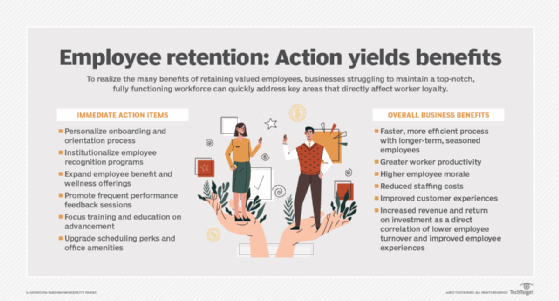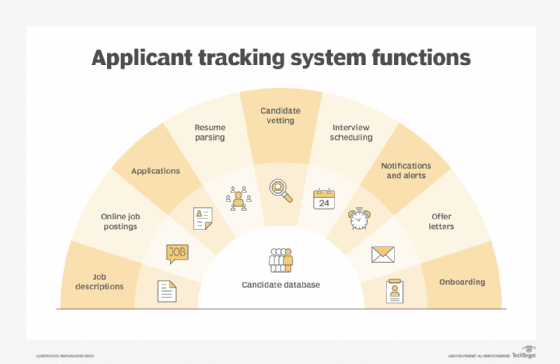employee retention
What is employee retention?
Employee retention is the organizational goal of keeping productive and talented workers and reducing turnover by fostering a positive work atmosphere to promote engagement. This includes showing appreciation to employees, providing competitive pay and benefits, and encouraging a healthy work-life balance.
Employers are particularly interested in retaining employees during periods of low unemployment and heightened competition for talent. To retain employees, organizations use human resources technology for recruiting, onboarding, engaging and recognizing workers, as well as offer more work flexibility and modern benefits like physical and financial wellness programs.
Why employee retention is important
Employee retention is important for team building and cohesion in the workplace so workers can trust and depend on each other.
Diminished productivity and competitive advantage are among the biggest losses when talented employees leave an organization. High employee turnover rates can harm an organization's ability to carry out its mission due to impairments to continuity, loss of institutional knowledge, and the high costs of replacing departing workers and training new replacements. Employee departures can also lower morale and prompt more employees to leave the organization.
For example, an organization might experience much slower progress on a project if it must continuously deal with the time, cost and lack of productivity that comes with continually onboarding and training new employees to fill vacant positions with high turnover rates. These new workers also need time to fully learn an organization's systems and to be productive.
This article is part of
Ultimate guide to recruitment and talent acquisition
Another negative effect of turnover is the impact on customers who notice that they're dealing with a continual flow of different people. High turnover typically signals to consumers that there's something wrong with the organization or brand.
Business benefits of employee retention
Employee engagement and employee experience are among the more important strategies in retaining valued workers and maintaining a positive employer-employee relationship. Significant business benefits include the following:
- Better process efficiency. Longer-term employees know how the company wants things done and possess institutional knowledge they can draw on, leading to greater work efficiencies and attaining company goals expediently.
- Greater worker productivity. Seasoned employees are often skilled at quickly and efficiently executing their tasks. Conversely, hiring new replacements typically causes delays and inevitable, prolonged and costly mistakes in workflows.
- Higher employee morale. Employees are more likely to have higher morale, take pride in their work and, therefore, perform better when they have a sense of belonging in the organization. High turnover rates can create the opposite effect.
- Reduced staffing costs. Recruitment and training can cost organizations significant amounts of money each year. Retaining employees is the best way to curb those costs.
- Improved customer experiences. Customers tend to strongly favor organizations where they see friendly and familiar faces over time and develop a relationship with one or more employees. Low turnover rates can increase positive customer perceptions.
- Increased revenue and ROI. There are direct correlations between increased revenues and lower employee turnover, higher employee morale and improved employee experiences.
- Decreased costs of hiring and recruiting. A high turnover rate is expensive in terms of time and money. Keeping knowledgeable employees saves on time needed to hire, onboard and train new employees.
- Improved company culture. A strong sense of company culture helps employees feel more invested in their team and their work. A positive company culture is inclusive, provides good benefits and celebrates its employees. A negative company culture could cause employees to feel less engaged and push them away from the company.
- Increased employee engagement. A workplace that values employee retention and sufficiently engages employees is more likely to see those employees stay.

Key causes of high employee turnover
Exit interviews and employee surveys reveal some of the more common reasons why employees quit their jobs, including the following:
- Poor compensation.
- Insufficient employee benefits.
- Lack of remote work and work-from-home opportunities.
- Minimal career development opportunities.
- Lack of work-life balance.
- Poor or undefined company culture.
- No sense of belonging with team members or the company at large.
- Lack of recognition or rewards.
- Concerns about the company's financial health.
- Better job opportunities elsewhere.
- Unhappy with management.
- Feeling disrespected.
Effective employee retention strategies
Companies concerned with retaining valued employees can take several immediate actions in key areas to help bolster their retention programs and lower turnover rates.
Onboarding. Companies focused on retaining employees usually start with the hiring and onboarding process by giving new workers adequate training and orientation about the company's culture. They also give new employees an opportunity to ask questions about their work and engage in dialogue with their supervisors. Employees are often offered, or at least surveyed on, flexible or hybrid work schedules to better ensure a good work-life balance and improve the overall employee experience. Some companies even offer reduced workdays. For example, an organization might enable employees to take every other Friday off.
Recognition, rewards and compensation. Some organizations use systematic recognition and reward strategies to show they value their employees. Some employers rely on employee engagement software that uses gamification and other techniques to recognize workers and provide rewards and perks like retail discounts. Employers also focus on competitive pay using employee compensation management software that compares pay rates with benchmarks for given regions, job titles and performance ratings.
Benefits. Employers seek to distinguish themselves in the hiring arena by offering varied benefits, including voluntary, employee-paid and corporate subsidized. Newer types of benefits include lower healthcare premiums, higher deductible health insurance plans, pet insurance, education debt repayment programs and legal counseling.
Performance feedback and reviews. To promote good communication and transparency, especially with the advent of remote and hybrid workforces, many companies don't wait for an annual review to evaluate an employee's performance. Instead, managers hold frequent one-on-one meetings with employees to provide constructive feedback, periodically discuss their professional interests and goals, and encourage new ideas.
Training, education and development. Companies offer employees opportunities for advancement through programs that provide upskilling, succession planning and attendance at conferences and webinars. They also promote programs that pair an employee with a mentor who can offer guidance and training in a specific area of expertise.
Perks. To foster work-life balance, many companies offer flexible work schedules, time off and shorter work weeks; telecommuting via work-from-home schedules; and remote work opportunities for extended vacation and holiday location stays. They also train managers to encourage employees to take vacations.
Amenities. Employers increasingly provide office amenities such as ergonomic and standing desks, subsidized meals, free refreshments, daycare, elderly care and relaxation hubs featuring games like table tennis and pool.
Emphasize teamwork. Focusing on building teamwork and collaboration encourages co-workers to bond and create friendships. It also creates a better work culture, can improve performance and can improve employee engagement.
Reduce burnout. Burnout is caused by overwork, lack of recognition or lack of rewards. Burnt-out employees might feel more pessimistic about their jobs and become less engaged.
Culture. Creating a strong company culture can incentivize and attract new potential workers and keep current employees engaged. Enacting a strong company culture can involve implementing any of the previous items listed.

Employee retention metrics and measuring
Typical metrics used in the measuring of employee retention include the following:
- Employee satisfaction. This metric lets businesses know how content employees are with their jobs. If this metric is low, it could indicate a potentially low retention rate.
- Retention rate. This percentage-based metric serves as a basic measurement of a company's ability to retain employees over time.
- Retention rate per manager. This is a measure of retention focused on rates per manager. With this metric, a company can investigate potential management-based problems with employee retention.
- Voluntary and involuntary turnover rate. These percentage-based metrics measure the rate at which staff members leave a company, either by choice or involuntarily due to terminations and layoffs.
- Turnover costs. These are costs such as hiring, onboarding and training. This metric determines the cost of turnover and its effects on the company.
- Average employment length. This metric measures the average time an employee stays at a company.
- Absence rate. This is a percentage of unplanned employee absences due to causes like sickness or personal emergencies.
- Absence rate per manager. This is a measure of employee absence focused on rates per manager. With this metric, a company can investigate potential management-based issues regarding absences.
HR departments can deploy employee engagement software to do pulse surveys on worker impressions of the company and take action to remedy areas where employees show low job satisfaction. Such surveys are usually anonymous and brief, so employees are more likely to participate.
Within an organization, a feeling of belonging and being heard are considered key aspects of employee retention. Workers also often cite the importance of managers who support them. Frequent surveys are a way to gauge employee feelings about their supervisor.
Employers use corporate wellness technology that encourages companywide teamwork through a variety of techniques, such as competitive activities and group volunteer projects. Promoting physical and psychological well-being is sometimes a key aspect of corporate wellness. For example, organizations can provide incentives and discounts on health insurance for employees who use wearables, mobile devices and other ways to track their physical health and activity.
Using HR software to improve employee retention
Depending on the application, there are numerous types of HR software available, including the following:
- Human capital management systems.
- Hybrid work systems.
- HR information systems.
- HR management systems.
- Applicant tracking systems.
- Payroll systems.
For hybrid work schedules, a new category of HR software manages flexible hours and work environments that blend on-premises and remote work scheduling for each employee, as well as space requirements such as hot desking, hoteling, customizable work hubs and conference areas. These tools can also play a role in managing employee retention efforts. In addition, HR information, management and capital management systems incorporate elements of employee retention tracking and management.
There are many ways for an organization to gauge and improve employee retention. Learn how people analytics can help HR improve employee retention.







